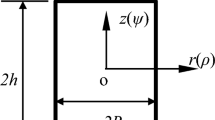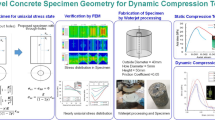Abstract
The rationale for using the circular cylindrical specimen for determining the tensile strength of concrete is reviewed, and the stress fields and fracture modes associated with the familiar splitting test and a pressurized cylinder test are discussed. Special attention is paid to contradictory reports and unresolved issues in the literature as to exactly how the fracture of a concrete cylinder develops and progresses under increasing load.
The effect of a macrocrack on the stress field within a cylinder is introduced as a means of understanding the progressive fracture of a cylindrical specimen. In particular, it is argued that, while the idealized stress field in an unflawed cylinder may explain how and where the first macrocrack develops in a cylindrical specimen, it is the stress field modified by the presence of the macrocrack that must be considered to understand subsequent behavior. This point of view enables us to take a unified view of a variety of different observations about the indirect tensile mode of failure.
The axial tensile failure of a concrete cylinder loaded by radial pressure is also considered in the context of classical elastic stress analysis. Whereas this failure mode has been described as “paradoxical” in the literature, we demonstrate that the induced tensile stress field is indeed of sufficient magnitude to explain the axial failure under radial pressure by an elementary strength of materials argument.
Résumé
On examine les motivations d'utiliser une éprouvette à section cylindrique pour déterminer la résistance à la traction du béton, et on discute des champs de contraintes et des modes de rupture correspondant à l'essai classique de séparation et à l'essai sur cylindres soumis à pression. Les rapports de caractère contradictoire, et les données non résolues figurant dans la littérature, sont examinés en particulier en ce qui regarde la maniére exacte selon laquelle se développe et progresse sous charges croissantes une rupture dans un cylindre en béton.
Un moyen de comprendre la rupture progressive d'une éprouvette cylindrique est d'introduire l'effet d'une microfissure sur le champ de contraintes dans un cylindre. En particulier, on avance que si un champ de contraintes idéal dans un cylindre sans défauts peut expliquer comment et où la première microfissure se développe dans une éprouvette cylindrique, c'est le champ de contraintes modifié par la présence des microfissures qui est à prendre en considération pour comprendre le comportement subséquent.
Cette opinion permet aux auteurs d'adopter une vision globale d'une série d'observations diverses sur un mode de rupture par contraintes indirectes.
On considère également le cas de la rupture par contraintes axiales d'un cylindre de béton sollicité par une pression radiale, dans le cadre d'une analyse classique des contraintes élastiques.
Bien que ce mode de rupture ait été décrit dans la littérature comme paradoxal, on démontre que l'amplitude du champ de contraintes de traction induites est bien suffisante pour expliquer la rupture axiale sous pression radiale, en recourant à une explication basée sur la résistance élémentaire des matériaux.
Similar content being viewed by others
Explore related subjects
Discover the latest articles and news from researchers in related subjects, suggested using machine learning.References
American Society for Testing and Materials, in Annual Book of ASTM Standards, vol. 0.042, (1984) 24–29.
American Society for Testing and Materials, in Annual Book of ASTM, Standards, vol. 0.042, (1984) 336–341.
J.M. Raphael, ACI Journal 84 (1984) 158–165.
P.J.F. Wright, Magazine of Concrete Research 7 (1985) 87–96.
A.M. Neville, Properties of Concrete, John Wiley and Sons, New York, (1973).
N. Clayton, Magazine of Concrete Research 30 (1978) 26–30.
N. Clayton and F.J. Grimer, Developments in Concrete Technology—I, F.D. Lydon (ed.), Applied Science Publishers, London (1979) 283–318.
F.J. Grimer and R.E. Hewitt, in Structure, Solid Mechanics and Engineering Design, Proceedings of the Southampton 1969 Civil Engineering Materials Conference, M. Te'eni (ed.) 618–691.
J.N. Goodier, Transactions of the American Society of Mechanical Engineers 53 (1932) 173–183.
F. Carneiro, “Une nouvelle methode d'essai pour determiner la resistance a la traction du beton.” Reunion des Laboratories d'Essai de Matriaux Paris (June 1947).
V.M. Malhotra and N.G. Zoldners, Journal of Materials 4 (1967) 160–184.
G. de C. Franca and G. Pincus, Journal of Materials 4 (1969) 393–407.
F.L.L. Carneiro and A. Barcellos, International Association of Testing and Research Laboratories for Materials and Structures, RILEM Bulletin 13 (1953) 99–125.
T. Akazawa, International Association of Testing and Research Laboratories for Materials and Structures, RILEM Bulletin 16 (1953) 13–23.
S. Timoshenko and J.N. Goodier, Theory of Elasticity, Second Ed., McGraw-Hill Book Company, New York (1951).
M.M. Frocht, Photoelasticity. Vol. II. John Wiley and Sons, New York (1943).
H. Hertz, Zeitschrift fur Mathematik and Physik 28 (1883) 125–128.
J.H. Michell, Proceedings of the London Mathematical Society XXXII (1990) 35–61.
W.-F. Chen and T.-Y.P. Chang, Journal of the Engineering Mechanics Division, Proceedings of the American Society of Civil Engineers 104 (1978) 691–704.
K.L. Seefried, H. Gerund and G. Pincus, Journal of Materials 2 (1967) 703–718.
D.J. Hannant, K.J. Buckley and J. Groft, Materiaux et Constructions 6 (1973) 15–21.
J.A. Hudson, E.T. Brown and F. Rummel, International Journal of Rock Mechanics and Mining Science 9 (1972) 241–248.
N.B. Mitchell, Materials Research and Standards 1 (1961) 780–788.
A. Rudnick, A.R. Hunter and F.C. Holden, Materials Research and Standards 3, (1963) 283–289.
P.S.B. Colback, Proceedings of the First Congress of the International Society of Rock Mechanics. Lisbon (September 1966).
M.K. Oladimeji, Engineering Fracture Mechanics 19 (1984) 717–738.
D.P. Rooke and D.J. Cartwright, Compendium of Stress Intensity Factors, Her Majesty's Stationery Office, London (1976).
Applications of Fracture Mechanics to Cementitious Composites, Proceedings of the NATO Advanced Research Workshop on Applications of Fracture Mechanics to Cementitious Composites, Northwestern University, September 4–7, 1984, S.P. Shah (ed.) Martinus Nijhoff Publishers (1985).
Fracture Mechanics of Concrete, F.H. Wittmann (ed.), Elsevier, Amsterdam (1983).
A. Hillerborg, M. Modeer and P.-E. Peterssen, Cement and Concrete Research 6 (1976) 773–782.
Z.P. Bazant and B.H. Oh, Materials and Structures 16 (1983) 155–177.
Y.S. Jenq and S.P. Shah, Journal of Engineering Mechanics 111 (1985) 1227–1241.
J.C. Jaeger and N.G.W. Cook, Fundamentals of Rock Mechanics, Methuen & Co., London (1969) 86.
R.P. Ojdrovic and H.J. Petroski, International Journal of Fracture 27 (1985) R75–80.
Author information
Authors and Affiliations
Rights and permissions
About this article
Cite this article
Petroski, H.J., Ojdrovic, R.P. The concrete cylinder: stress analysis and failure modes. Int J Fract 34, 263–279 (1987). https://doi.org/10.1007/BF00013082
Received:
Accepted:
Issue Date:
DOI: https://doi.org/10.1007/BF00013082




